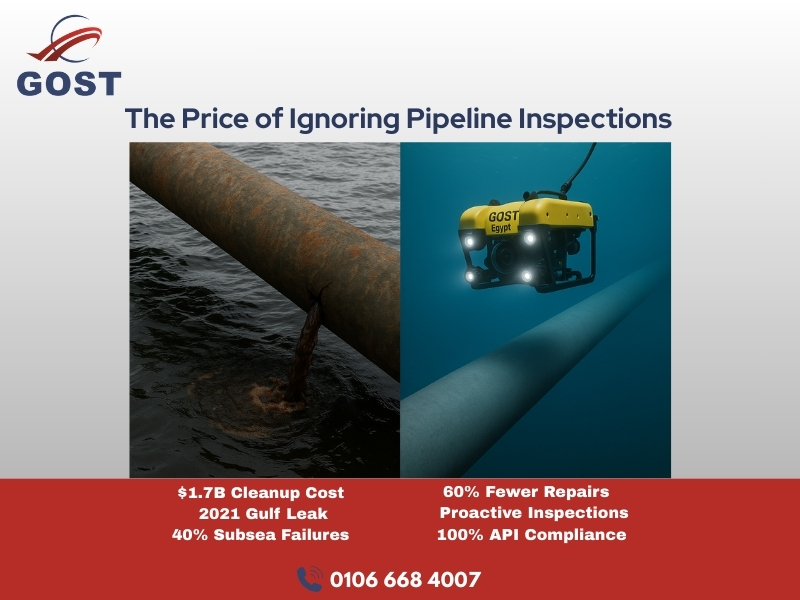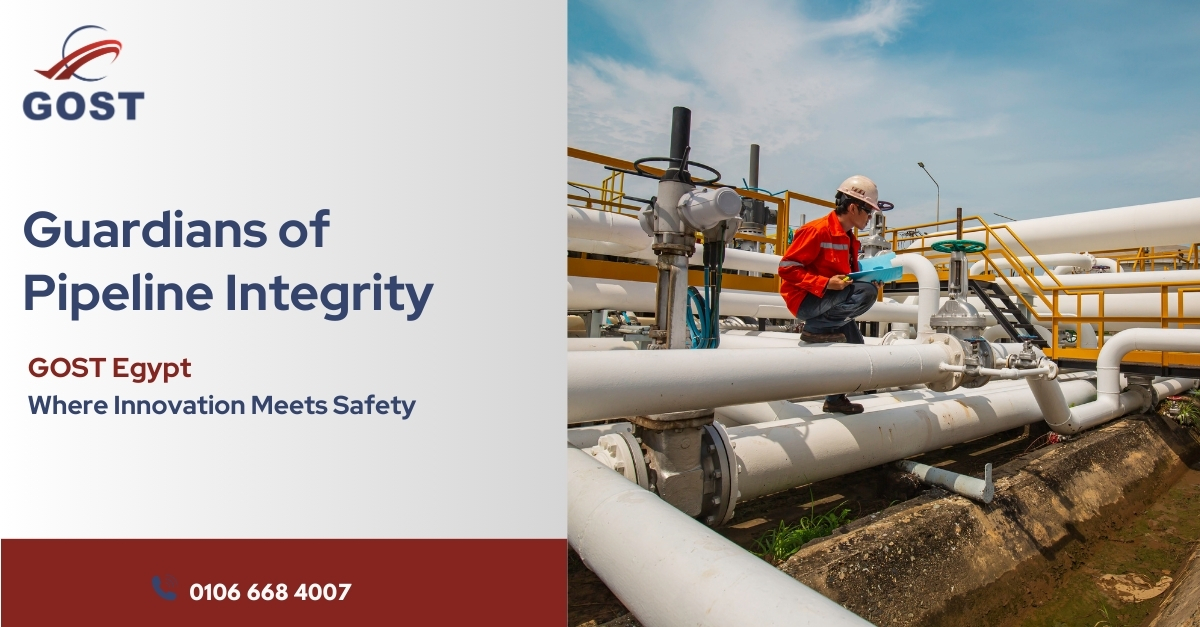Pipeline inspection is the unsung hero of global energy security, ensuring the safe and efficient flow of resources through over 3.5 million miles of pipelines worldwide. These vast networks—enough to circle the Earth 140 times—fuel industries, heat homes, and power economies. Yet, their silent operation masks a stark reality: a single undetected flaw can unleash environmental disasters, financial ruin, or even loss of life. Corrosion alone accounts for 30% of pipeline failures, according to industry studies, turning minor oversights into billion-dollar crises.
At GOST Egypt, we transform this vulnerability into reliability. As a leader among oil and gas pipeline inspection companies, we combine cutting-edge technologies like UAV surveys and AI analytics with decades of hands-on expertise. Our mission? To deliver precision where it matters most—protecting infrastructure, communities, and the planet—through proactive, data-driven pipeline inspection services.
Why Pipeline Inspection Matters

A single oversight in pipeline inspection can cascade into irreversible consequences. Consider this: the National Association of Corrosion Engineers (NACE) reports that corrosion alone causes 30% of pipeline failures, leading to leaks, explosions, and environmental contamination. Beyond corrosion, undetected cracks, weld defects, or external damage can disrupt operations, endanger workers, and devastate ecosystems. For instance, a 2021 incident in the Gulf of Mexico resulted in $1.7 billion in cleanup costs after a ruptured gas pipeline leaked for weeks.
Effective inspections address three pillars of protection:
- Safety First:
- Prevent accidents threatening field personnel and nearby residents.
- Mitigate risks of fires, toxic exposure, or long-term soil/water pollution.
- Regulatory Compliance:
- Align with ASME B31.8 (gas pipelines) and API 570 (inspection standards) to avoid fines, lawsuits, or shutdowns.
- At GOST Egypt, our inspections prioritize safety and regulatory alignment, ensuring audits pass seamlessly.
- Cost-Efficiency:
- Proactive maintenance reduces emergency repairs by up to 60% (DNV GL study).
- Early detection of issues like corrosion in oil pipeline inspection or weld flaws in gas pipeline inspection slashes downtime and extends asset lifespan.
For industries relying on pipelines, skipping inspections isn’t just risky—it’s financially reckless. A single unplanned outage can cost millions per day, while leaks in pipeline inspection zones amplify ecological liabilities.
Advanced Methods Powering Modern Pipeline Inspections
The days of relying solely on manual checks for pipeline integrity are over. Today, cutting-edge technologies deliver unmatched accuracy, speed, and safety in pipeline inspection services, ensuring flaws are detected long before they escalate.
Inline Inspection (ILI)
ILI tools, often called “smart pigs,” traverse pipelines internally, capturing data without excavation. Two standout methods include:
- Magnetic Flux Leakage (MFL):
Detects corrosion, pits, and metal loss by measuring magnetic field disruptions. Ideal for oil and gas pipeline inspection due to its ability to scan through coatings. - Ultrasonic Testing (UT):
Uses high-frequency sound waves to identify cracks, weld defects, or wall thickness variations. Critical for ultrasonic pipeline inspection in high-pressure gas lines.
Why ILI Dominates:
- Inspects 100% of the pipe’s interior, unlike spot-checking.
- Reduces downtime—tools travel with the product flow.
- Provides 3D maps of defects for targeted repairs.
- Eliminates risks of human error in inline pipeline inspection.
Drone & UAV Inspections
When pipelines stretch across deserts, mountains, or disaster zones, drones revolutionize accessibility. GOST Egypt’s industrial-grade UAVs equipped with thermal cameras and LiDAR:
- Survey thousands of miles in hours, slashing inspection time by 70%.
- Detects encroachments, leaks, or soil erosion in remote oil pipeline inspection projects.
- Assess post-flood or fire damage without risking worker safety.
A 2023 study showed UAVs reduce inspection costs by 45% in gas pipeline inspection networks, while improving data granularity.
NDT Techniques
Non-destructive testing (NDT) methods evaluate pipelines without compromising their structure:
- Radiography: X-rays or gamma rays reveal hidden weld defects or internal corrosion.
- Eddy Current Testing: Electromagnetic fields detect surface cracks in pipeline welding inspection.
- Laser Scanning: Creates millimeter-accurate 3D models for pipeline construction inspection quality assurance.
These methods are indispensable for pipeline NDT inspection, particularly in aging infrastructure where invasive techniques are too risky.
Choosing the Right Pipeline Inspection Partner
Selecting a pipeline inspection provider isn’t just about ticking boxes—it’s about finding a partner that aligns with your operational risks, regulatory demands, and long-term goals. Here’s what to prioritize:
5 Criteria for a Reliable Inspection Partner
- Sector-Specific Expertise:
Oil, gas, and water pipelines face unique challenges. For instance, gas pipeline inspection requires leak detection sensitivity, while oil pipeline inspection focuses on corrosion in crude-carrying lines. Ensure your provider understands your industry’s nuances. - Certified Technologies:
Advanced tools like MFL pipeline inspection devices or phased array ultrasonic testing (PAUT) should be industry-certified. Avoid providers relying on outdated methods prone to missed defects. - Adherence to Standards:
Compliance with API 1163 (ILI qualifications) and ASME B31.4/B31.8 ensures inspections meet global safety benchmarks. Non-compliance risks fines and operational halts. - Emergency Readiness:
Leaks or ruptures demand rapid response. Look for 24/7 support teams equipped for urgent gas line inspection scenarios. - Transparent Reporting:
Detailed, jargon-free reports with visual data (e.g., 3D defect maps) enable informed decisions. Avoid providers that drown you in raw data without actionable insights.
Why GOST Egypt Stands Out
With over 20 years of experience in industrial pipe inspection, GOST Egypt merges deep sector knowledge with agility. For example:
- Certified Tech: Our fleet includes API-compliant MFL tools and UAVs for drone pipeline inspection in remote areas.
- Emergency Excellence: When a Middle Eastern gas operator faced a suspected leak, our team deployed within 4 hours, using inline inspection tools to pinpoint and resolve the issue, averting a shutdown.
- Clarity in Data: We provide interactive dashboards that highlight critical findings, repair priorities, and compliance status—simplifying audits and maintenance planning.
In an industry where “good enough” isn’t acceptable, GOST Egypt delivers precision, transparency, and responsiveness—cornerstones of world-class pipeline inspection services.
In an industry where precision is non-negotiable, GOST Egypt for Inspection Services stands as a guardian of pipeline integrity, blending innovation with an unwavering commitment to safety. Every inspection we conduct is more than a service—it’s a pledge to protect communities, preserve ecosystems, and prolong the lifespan of critical infrastructure. From safeguarding subsea gas lines with ROVs to deploying AI-driven analytics for predictive maintenance, our solutions are tailored to meet the unique challenges of your operations.
With over 20 years of expertise, GOST Egypt has redefined what it means to deliver excellence in pipeline inspection services. We don’t just identify risks; we empower you to eliminate them, ensuring compliance, efficiency, and peace of mind.
FAQs about Pipeline Inspection
What is in-line pipeline inspection?
In-line inspection (ILI) involves sending advanced tools, often called “smart pigs,” through pipelines to detect issues like corrosion, cracks, or weld defects without excavation. Techniques like Magnetic Flux Leakage (MFL) and Ultrasonic Testing (UT) provide detailed data on pipe health. Leading inline pipeline inspection companies, like GOST Egypt, use ILI to minimize downtime and maximize accuracy.
What are the methods of pipe inspection?
Modern methods include:
- Inline Inspection (ILI): For internal defects (e.g., MFL, UT).
- Drone/UAV Pipeline Inspection: For aerial surveys of remote or hazardous areas.
- NDT Pipeline Inspection: Non-destructive tests like radiography or eddy current for surface and subsurface flaws.
At GOST Egypt, we tailor methods to your needs—whether it’s pipeline inspection or gas pipeline inspection.
Can inspections prevent leaks entirely?
While no method guarantees 100% prevention, regular inspections reduce leak risks by up to 60% (per DNV GL). Advanced tools like ultrasonic pipeline inspection and AI analytics help catch 95% of defects early. GOST Egypt’s proactive approach ensures leaks are rare, manageable, and never catastrophic.
How often should pipelines be inspected?
Frequency depends on factors like age, material, and environment. Industry standards recommend:
- High-risk zones (e.g., gas pipelines): Every 3-5 years, with annual visual checks.
- Low-risk areas: 5-7 years.
For precise schedules, GOST Egypt conducts risk assessments aligned with API 570 guidelines, ensuring your oil pipeline inspection or gas line inspection stays ahead of threats.
Contact Us
For expert pipeline inspection services tailored to your needs, GOST Egypt is here to assist. Whether you require routine assessments, emergency gas line inspections, or advanced UAV pipeline inspection solutions, our teams in Alexandria and Cairo are ready to deliver precision and reliability.
Head Office
- Address: 122 Galal El Desouki Street, Wabor Elmyah, Bab Sharki, Royal Palace Tower, Alexandria, Egypt
- Email: info@gostegypt.com
- Phone: +2 03 4228 204 – 4228 234
- Mobile: +2 0106 668 4007
- Fax: +2 03 4228 234
Cairo Office
- Address: 8 El Sudan Street, El Dokki, Cairo, Egypt
- Email: cairo@gostegypt.com
- Phone: +2 02 3760 6450
- Mobile: +2 0109 002 6744
GOST Egypt combines cutting-edge technology with 20+ years of industry experience. Reach out today for a consultation—we prioritize responsiveness, clarity, and results.

